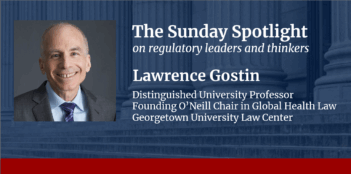
The COVID-19 pandemic raises questions about how decision-makers should distribute medical resources.
Even absent a pandemic, physicians must sometimes ration medical resources, but the scarcity of health care resources has come into sharp focus in light of the COVID-19 pandemic. Around the world, physicians have faced the decision of how to handle having too many COVID-19 infected patients and too few ventilators.
Italy presented one of the most drastic instances of medical rationing, as professional health organizations instructed physicians to prioritize younger patients over older patients or patients with other health complications. The United States is also facing potential rationing challenges as COVID-19 continues to spread, with the threat of running out of ventilators, ICU beds, and other medical resources looming over physicians and their patients.
For example, in April, the Northwell Health System of New York released a memo outlining its rationing protocol for intensive care. The protocol reportedly recommended that patients with preexisting advanced illnesses be reevaluated three days after being placed on a ventilator, while otherwise healthy patients would not be reevaluated for at least seven days. A recently leaked internal document from the Henry Ford Health System in Detroit, Michigan outlined its rationing plan, which focused on prioritizing patients based on the severity of their symptoms, preexisting conditions, and advanced directives. As of yet, neither health system has apparently needed to implement these rationing protocols.
Medical ethicists have developed three principles to frame rationing decisions: utilitarianism, egalitarianism, and prioritarianism. Utilitarianism emphasizes making decisions to maximize the good achievable with scarce resources. Egalitarianism focuses on trying to provide an equal opportunity for care to each individual. Prioritarianism stresses prioritizing the most vulnerable or disadvantaged groups when resources are scarce. Although each framework has its proponents and opponents, physicians have used these three underlying principles at the bedside as they attempt to allocate resources.
Rationing decisions and policies are not created in a bubble; health care providers, consumers, and the government all participate to varying degrees. Health care providers often engage in some level of bedside rationing. Consumers self-ration by opting for less costly treatments or by refusing to seek treatment. The government is involved in the U.S. health system in many ways, and each interaction is an opportunity for the government, and therefore the public, to influence rationing decisions.
This week’s Saturday Seminar focuses on the legal and ethical justifications for, and limits to, the rationing of medical resources.
- Elizabeth Hein, an associate at Post & Schell PC, examines recent medical resource allocation guidelines from the Pennsylvania Department of Health and the Hospital and Healthsystem Association of Pennsylvania. Based on an aim to maximize the number and quality of lives, the guidelines create a framework for the allocation of scarce resources such as ventilators and intensive care unit (ICU) beds. Although the guidelines may provide health care providers with some level of protection against malpractice suits, Hein argues that the legality of rationing in Pennsylvania is far from secure. Unlike other states, such as New Jersey, Pennsylvania does not provide health care providers with any form of immunity against COVID-19 related legal action. Hein calls for Pennsylvania physicians and health systems to be proactive by grappling with the question of rationing before the need arises.
- Due to scant federal and state guidance, several medical organizations have issued their own sets of rules and procedures on resource allocation. Some experts argue that these protocols raise troubling civil rights issues when they exclude disabled individuals. In an article for the Florida Law Review, Wendy F. Hensel and Leslie E. Wolf explore the legal ramifications of proposed allocation procedures that, they argue, run counter to the Americans with Disabilities Act. In keeping with society’s commitment to equality, Hensel and Wolf suggest creating a framework for the public health planning process that can better incorporate the interests of individuals with disabilities.
- “Existing recommendations for how to allocate scarce critical care resources during a pandemic or disaster contain ethically problematic provisions,” declare the University of Pittsburgh School of Medicine’s Douglas White and the University of California, San Francisco School of Medicine’s Bernard Lo. In a viewpoint published in the Journal of the American Medical Association, they caution against categorically excluding certain populations of patients, such as those with comorbid conditions, from access to scarce ICU resources. White and Lo suggest that prioritizing patients most likely to survive is a relevant but incomplete criterion for allocating life-saving resources. They argue that to maximize social welfare, other considerations should include the potential number of years of life saved, equal opportunity for patients to experience the stages of life, and heightened priority for those who serve essential roles during the pandemic.
- In a recent article published in Health Affairs, Somnath Saha and Mary Catherine Beach argue that as the COVID-19 outbreak continues, there may be a shortage of resources needed to treat patients. They suggest that demand may exceed the supply of emerging treatment options, and a shortage of resources needed to treat patients may result in unequal treatment during the pandemic. Through an examination of the Oregon Health Plan, which highlights the state’s extensive experience with health care prioritization, Saha and Beach outline a model for ensuring fair resource allocation and unbiased rationing of supplies. To maintain the public’s trust, they assert that implementing processes that protect against bias and other forms of institutional discrimination could reduce public fear and anxiety.
- When allocating medical resources in a pandemic, the ethical value of maximizing benefits is most important, Ezekiel Emanuel and his coauthors assert in a recent article in The New England Journal of Medicine. They argue that, in practice, this principle means giving priority to people most at risk of “dying young and not having a full life” over “those who are unlikely to recover even if treated and those who are likely to recover without treatment.” In addition, the value of maximizing benefits justifies removing a patient from a ventilator or ICU bed to provide that resource to a patient with a better prognosis, they argue. Emanuel and his coauthors state that “many guidelines agree that the decision to withdraw a scarce resource to save others is not an act of killing and does not require the patient’s consent.” They also argue that critical COVID-19 aid should be given first to frontline health care workers, and that patients with similar prognoses should be helped in a random order rather than a first-come, first-served basis.
- In an article published in the Pepperdine Law Review, Jessica Mantel of the University of Houston Law Center argues that health law and ethics should consider physicians’ roles using a “dual duty of care” paradigm. Her proposed dual duty of care incorporates the traditional “patient-centered duty of care,” where medical professionals prioritize the best interests of individual patients, with health care cost concerns and promotion of the public interest. She argues that the dual duty of care, however, limits the patient-centered duty of care “by the physician’s competing obligations to society.” As a result, physicians act as gatekeepers—rather than patient advocates. Physicians thus balance patients’ individual needs, including care that may benefit the patient, with the interests of society.
The Saturday Seminar is a weekly feature that aims to put into written form the kind of content that would be conveyed in a live seminar involving regulatory experts. Each week, The Regulatory Review publishes a brief overview of a selected regulatory topic and then distills recent research and scholarly writing on that topic.



